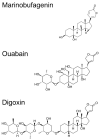Endogenous Mammalian Cardiotonic Steroids-A New Cardiovascular Risk Factor?-A Mini-Review
- PMID: 34440471
- PMCID: PMC8398695
- DOI: 10.3390/life11080727
Endogenous Mammalian Cardiotonic Steroids-A New Cardiovascular Risk Factor?-A Mini-Review
Abstract
The role of endogenous mammalian cardiotonic steroids (CTS) in the physiology and pathophysiology of the cardiovascular system and the kidneys has interested researchers for more than 20 years. Cardiotonic steroids extracted from toads or plants, such as digitalis, have been used to treat heart disease since ancient times. CTS, also called endogenous digitalis-like factors, take part in the regulation of blood pressure and sodium homeostasis through their effects on the transport enzyme called sodium-potassium adenosine triphosphatase (Na/K-ATPase) in renal and cardiovascular tissue. In recent years, there has been increasing evidence showing deleterious effects of CTS on the structure and function of the heart, vasculature and kidneys. Understanding the role of CTS may be useful in the development of potential new therapeutic strategies.
Keywords: Na/K-ATPase; heart failure; hypertension; marinobufagenin; ouabain.
Conflict of interest statement
The authors declare no conflict of interest.
Figures
References
-
- Dmitrieva R.I., Bagrov A.Y., Lalli E., Sassone-Corsi P., Stocco D.M., Doris P.A. Mammalian bufadienolide is synthesized from cholesterol in the adrenal cortex by a pathway that Is independent of cholesterol side-chain cleavage. Hypertension. 2000;36:442–448. doi: 10.1161/01.HYP.36.3.442. - DOI - PubMed
Publication types
LinkOut - more resources
Full Text Sources
Research Materials



